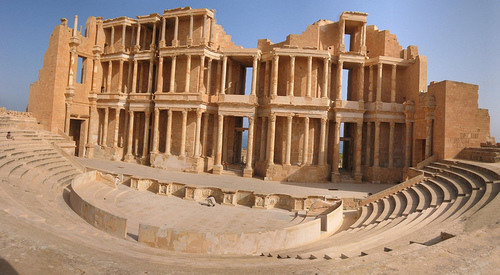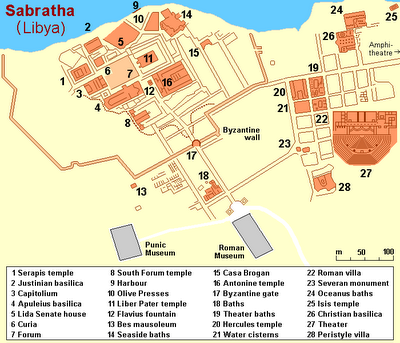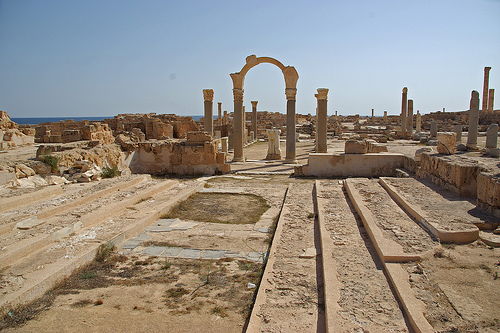

Location: 40 km East of Zuwarah, Zawiya District Map
When to visit: May- Sept

Sabratha, one of the most significant archaeological sites in Libya, is a well-preserved ancient city located on the Mediterranean coast, about 70 kilometers west of Tripoli. As one of the three great cities of the Roman province of Tripolitania (alongside Leptis Magna and Oea), Sabratha is renowned for its rich history, stunning architecture, and cultural importance, earning it a place on UNESCO’s World Heritage List in 1982.
Sabratha’s origins trace back to the Phoenicians, who
established it as a trading post around the 7th century BCE. Its
name likely derives from a Punic term, possibly linked to the
Berber word for “grain market,” reflecting its early role as a
commercial hub. Strategically positioned on the Mediterranean,
Sabratha facilitated trade between the African interior and
regions across the sea, including Greece, Rome, and the eastern
Mediterranean.
Phoenician and Punic Periods: Sabratha
began as a modest settlement, serving as a port for exporting
goods like ivory, ostrich feathers, and agricultural products
from the fertile hinterlands. Under Carthaginian influence, it
grew in importance, adopting Punic culture and religious
practices.
Roman Period: After Rome’s victory in the Punic
Wars, Sabratha came under Roman control by the 2nd century BCE.
It flourished during the 1st–3rd centuries CE, particularly
under the emperors Augustus and the Severan dynasty, becoming a
prosperous city with monumental architecture. Its wealth stemmed
from trade in olive oil, grain, and exotic goods, as well as its
role in the trans-Saharan trade network.
Decline: Sabratha
began to decline in the 4th century CE due to economic shifts,
barbarian invasions, and a devastating earthquake around 365 CE.
The city was briefly revived under Byzantine rule, but it was
abandoned after the Arab conquest in the 7th century, leaving it
buried under sand until rediscovered by archaeologists.
Sabratha’s archaeological site spans a large area and includes
some of the best-preserved Roman and pre-Roman structures in
North Africa. Below are the highlights:
1. The Theater
Description: The Roman theater, built in the late 2nd century
CE, is Sabratha’s most iconic monument and one of the finest
examples of Roman theater architecture in the Mediterranean. It
could seat around 5,000 spectators and features a three-story
stage backdrop (scaenae frons) adorned with 96 Corinthian
columns, intricately carved reliefs, and niches for statues.
Notable Features: The theater’s backdrop, restored by Italian
archaeologists in the 20th century, stands nearly 20 meters high
and is remarkably intact. The orchestra and seating areas are
well-preserved, and the stage includes trapdoors and mechanisms
for theatrical effects. The theater is still used occasionally
for performances, showcasing its enduring functionality.
Cultural Significance: The theater hosted plays, gladiatorial
contests, and public events, reflecting Sabratha’s wealth and
cultural sophistication.
2. The Forum and Basilica
Forum: The forum was the civic and commercial heart of Sabratha,
surrounded by temples, administrative buildings, and shops. It
was paved with marble and featured statues of emperors and
deities.
Basilica: Adjacent to the forum, the basilica served
as a law court and public meeting space. It was later converted
into a Christian church in the Byzantine period, with evidence
of a baptistery and Christian mosaics. The basilica’s columns
and apses are still standing, offering insight into Roman civic
architecture.
3. Temples
Sabratha boasts several
temples dedicated to Roman, Punic, and Egyptian deities,
reflecting its multicultural heritage:
Temple of Liber
Pater: Dedicated to the Punic god Shadrapa (Romanized as Liber
Pater), this temple blends Punic and Roman architectural styles.
Temple of Isis: Located near the sea, this temple reflects the
influence of Egyptian cults in the region. It features intricate
stucco work and a sacred enclosure.
Temple of Serapis: A
grand structure dedicated to the Greco-Egyptian god, indicating
the city’s cosmopolitan religious life.
4. Mosaics and
Houses
Mosaics: Sabratha is famous for its vibrant floor
mosaics, found in public buildings and wealthy homes. These
mosaics depict mythological scenes, marine life, and geometric
patterns, showcasing the skill of local artisans. The House of
the Nereids and the House of the Triumph of Dionysus contain
particularly fine examples.
Residential Areas: Elite homes,
such as the House of the Mosaics, feature peristyle courtyards,
frescoed walls, and private bath complexes, illustrating the
opulent lifestyle of Sabratha’s upper class.
5. Baths and
Infrastructure
Oceanus Baths: These public baths, named after
a mosaic depicting the sea god Oceanus, include hot and cold
rooms, hypocaust heating systems, and elaborate decorations.
They highlight the advanced engineering of Roman urban planning.
Aqueducts and Cisterns: Sabratha’s water supply relied on
aqueducts and underground cisterns, some of which are still
visible, demonstrating the city’s sophisticated infrastructure.
6. Punic Mausoleum
Known as the “Mausoleum of Bes,” this
pre-Roman structure is a rare surviving example of Punic
funerary architecture. It features a tall, obelisk-like tower
with reliefs of lions and mythological figures, blending Punic
and Hellenistic influences.
7. Amphitheater and Harbor
Amphitheater: Located outside the city walls, the amphitheater
hosted gladiatorial contests and animal hunts. Though less
preserved than the theater, it remains an impressive structure.
Harbor: Sabratha’s ancient harbor, now partially silted, was a
vital link in Mediterranean trade. Remnants of quays and
warehouses are still visible along the coastline.

Sabratha’s importance lies in its role as a cultural and economic
crossroads. Its architecture and artifacts reflect a blend of
Phoenician, Punic, Roman, and Byzantine influences, making it a
microcosm of Mediterranean history.
Trade Hub: Sabratha connected
sub-Saharan Africa with the Mediterranean, facilitating the exchange of
goods, ideas, and cultures. Its markets traded in gold, slaves, and
exotic animals alongside local olive oil and grain.
Multicultural
Society: The city’s religious diversity—evident in temples to Punic,
Roman, and Egyptian gods—highlights its cosmopolitan character. This is
further reflected in its art, which combines African, Hellenistic, and
Roman styles.
Archaeological Value: Sabratha’s well-preserved
structures provide invaluable insights into Roman urban planning,
architecture, and daily life. Its mosaics and theaters are among the
finest in the Roman world.
Sabratha’s archaeological site has faced significant challenges in
recent decades, particularly due to Libya’s political instability.
Preservation: Italian archaeologists excavated and restored much of
Sabratha in the early 20th century during Italy’s colonial period.
However, ongoing conflict in Libya since 2011 has limited conservation
efforts. Looting, vandalism, and neglect threaten the site, though it
remains relatively intact compared to other Libyan heritage sites.
UNESCO Status: Listed as a World Heritage Site, Sabratha was placed on
UNESCO’s List of World Heritage in Danger in 2016 due to threats from
conflict and urban encroachment.
Tourism: Before Libya’s civil
unrest, Sabratha was a major tourist destination. Today, access is
restricted, and the site sees few visitors, though its proximity to
Tripoli makes it a potential draw for future tourism if stability
returns.
Modern Context: The modern town of Sabratha, adjacent to the
ancient site, is a coastal community with historical ties to the ancient
city. It has occasionally been caught up in Libya’s conflicts, affecting
the site’s accessibility.
For those interested in visiting Sabratha in more stable times, the
site offers a compact yet breathtaking experience:
Highlights:
Prioritize the theater, forum, and Oceanus Baths. The Punic Mausoleum
and Temple of Isis are must-sees for their unique cultural blend.
Tips: Wear comfortable shoes for walking on uneven terrain, and bring
water, as facilities are limited. Guided tours, when available, provide
valuable context.
Nearby Sites: Combine a visit with Leptis Magna,
another Roman city 100 kilometers east, for a comprehensive exploration
of Tripolitania’s heritage.